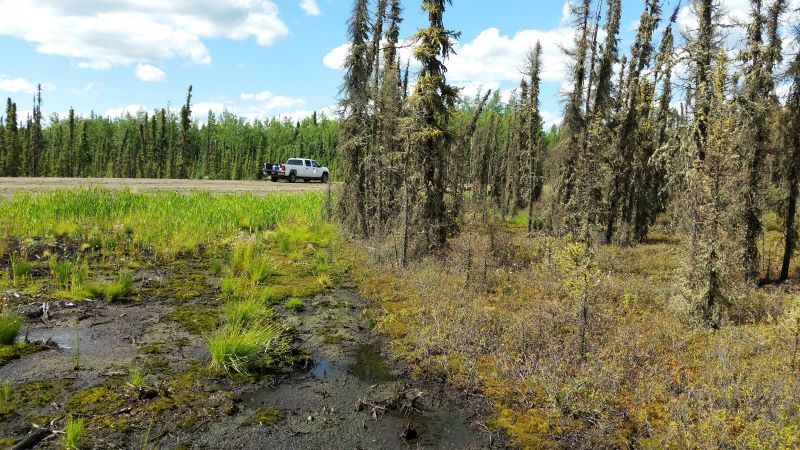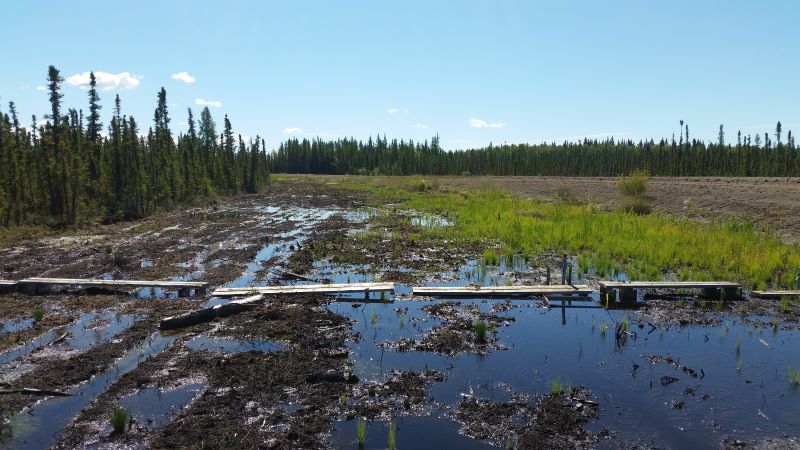6 December 2019
Peatlands release more methane when disturbed by roads
Posted by egarciadejesus
By Erin I. Garcia de Jesus
Roads built through acidic wetlands may make greenhouse gas emissions from the wetlands spike by damming natural water flow, according to a new study.
As plants die in bogs or fens—two types of wetlands—they sink into an acidic and low-oxygen environment where microorganisms can’t break them down as quickly as they would in other habitats. Over time, partially decomposed plants accumulate and create peat, a brown deposit that looks like soil. Its high carbon content allows it to burn.
Peat wetlands, also known as peatlands, store twice as much carbon as forests despite covering less than 3 percent of land. They are most common across the northern reaches of North America and Europe, where workers remove bricks of muddy peat for use as fertilizer or some countries burn it as fuel to heat homes and businesses.
Now, new research in AGU’s Journal of Geophysical Research: Biogeosciences suggests building roads across these areas for transport and to extract natural resources may boost emissions of methane, a potent greenhouse gas, up to 49 times the natural level. Methane in the atmosphere absorbs heat more effectively than carbon dioxide, meaning it poses a greater threat for global climate change.
Changing water levels
Bogs and fens are more acidic than other types of wetlands and naturally provide around 7 percent of global methane emissions. The main difference between the two peat habitats is how they receive water. Streams flow freely through fens, while bogs depend on rainfall to replenish water.
When microbes slowly break down plants in these areas under waterlogged conditions, they release methane as a byproduct. The gas then either remains in the peat or diffuses into the atmosphere. Man-made structures, such as roads, can disrupt these natural processes and cause peatlands to emit more methane, according to the new study.
“When people construct these roads, they are impacting the peatlands because they put in external materials that impede water movement,” said Saraswati, an ecohydrologist at the University of Waterloo in Ontario, Canada and lead author of the study.
More than 217,000 kilometers (nearly 135,000 miles) of roads crisscross the northern parts of Canada, which has a high density of peatlands. To determine the impact roads have on methane emissions, Saraswati and her colleague, Maria Strack, a wetland biogeochemist at the University of Waterloo, focused on a bog and a fen located in Carmon Creek, an oil extraction project in northern Alberta. In 2016 and 2017, the pair collected samples from enclosed chambers inserted into the peat, which captured gas emissions.
“We thought there would be more impacts in the fen because it receives a lot of external nutrients from streams and disturbances might impact water movement,” Saraswati said. “But when we got our results it was totally different.”
She and Strack discovered the bog released more methane in spots close to a road that cut perpendicular to the direction of water flow, compared to an area 50 meters (164 feet) away. Meanwhile the fen—which had a road crossing parallel to its water flow and therefore didn’t disrupt its movement—emitted similar amounts of methane both close and far away from the road.
Within the bog, the pair discovered areas upstream of the road emitted 16 times more methane on average in 2016 compared to those downstream. The increase was most apparent in upstream spots far away from culverts, which help water continue to flow underneath the road. In 2017, when there was less rain, upstream spots released around 49 times more methane.

Saraswati, an ecohydrologist at the University of Waterloo, measures carbon dioxide fluxes at her field site in northern Canada. Credit: Courtesy of Saraswati
The new results suggest roads lying perpendicular to the direction of water flow disconnect sections of the wetland and change the water levels. Close to the road in the bog, the water level was shallower, also making the underlying peat warmer. This may help microbes decompose dead plants more quickly, which releases more methane in the atmosphere.
When building roads in peatlands, it’s important to consider how roads will impact water in the region, Saraswati noted.
“If you want to save those ecosystems, the best thing to do is to avoid constructing roads and look at the direction of the water flow” Saraswati said. “If it’s possible, try to construct the road parallel to the water flow rather than perpendicular. And if that’s not possible, install more culverts.”
Erin I. Garcia de Jesus is a science writing intern at AGU. Follow her on Twitter @viruswhiz




 GeoSpace is a blog on Earth and space science, managed by AGU’s Public Information staff. The blog features posts by AGU writers and guest contributors on all sorts of relevant science topics, but with a focus on new research and geo and space sciences-related stories that are currently in the news.
GeoSpace is a blog on Earth and space science, managed by AGU’s Public Information staff. The blog features posts by AGU writers and guest contributors on all sorts of relevant science topics, but with a focus on new research and geo and space sciences-related stories that are currently in the news.
My god, I can hardly believe I am reading this in 2019. It’s so obvious, it has long has been scientifically proven, that peat bogs are a MASSIVE CARBON STORE, much more even than forests.
Please read these articles, and links to relevant sites.
Thanks.
https://www.biographic.com/refilling-the-carbon-sink/
https://www.theflowcountry.org.uk/
https://www.theguardian.com/environment/2019/nov/27/scotlands-peat-bogs-reveal-their-secret-strength-carbon-aoe
The English elite even royals, evaded tax by destroyiing Scotand’s peat bogs, draining and planting pine trees for almost 2 decades. The SNP Scotgov have been attempting to repair the dreadful damage just very recently, no funds made availavle from the Gov in Eng who wrecked the Flow country and oter areas of Scotalnd, for money, for greed. sadly the Flow Country has not been awarded WHS status because the government in Eng, ( it’s a reserved power), have not ‘approved’ it for such hugely crucial protective status. I fear they have other ideas for this area of Scotland, in future.
Hetty.
Sorry the typos, trying to do dinner at the same time as writing.